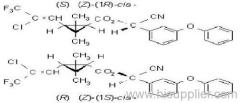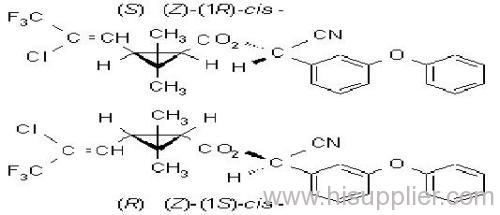Common name: lambda-cyhalothrin; lambda-cyhalothrine
IUPAC name: A reaction product comprising equal quantities of (S)-a-cyano-3-phenoxybenzyl (Z)-(1R,3R)-3-(2-chloro-3,3,3-trifluoroprop-1-enyl)-2,2-dimethylcyclopropanecarboxylate and (R)-a-cyano-3-phenoxybenzyl (Z)-(1S,3S)-3-(2-chloro-3,3,3-trifluoroprop-1-enyl)-2,2-dimethylcyclopropanecarboxylate
Roth: (S)-a-cyano-3-phenoxybenzyl (Z)-(1R)-cis-3-(2-chloro-3,3,3-trifluoropropenyl)-2,2-dimethylcyclopropanecarboxylate and (R)-a-cyano-3-phenoxybenzyl (Z)-(1S)-cis-3-(2-chloro-3,3,3-trifluoropropenyl)-2,2-dimethylcyclopropanecarboxylate (1:1)
Chemical Abstracts name: [1a(S*),3a(Z)]-(cyano(3-phenoxyphenyl)methyl 3-(2-chloro-3,3,3-trifluoro-1-propenyl)-2,2-dimethylcyclopropanecarboxylate
CAS RN: [91465-08-6]
IUPAC name: A reaction product comprising equal quantities of (S)-a-cyano-3-phenoxybenzyl (Z)-(1R,3R)-3-(2-chloro-3,3,3-trifluoroprop-1-enyl)-2,2-dimethylcyclopropanecarboxylate and (R)-a-cyano-3-phenoxybenzyl (Z)-(1S,3S)-3-(2-chloro-3,3,3-trifluoroprop-1-enyl)-2,2-dimethylcyclopropanecarboxylate
Roth: (S)-a-cyano-3-phenoxybenzyl (Z)-(1R)-cis-3-(2-chloro-3,3,3-trifluoropropenyl)-2,2-dimethylcyclopropanecarboxylate and (R)-a-cyano-3-phenoxybenzyl (Z)-(1S)-cis-3-(2-chloro-3,3,3-trifluoropropenyl)-2,2-dimethylcyclopropanecarboxylate (1:1)
Chemical Abstracts name: [1a(S*),3a(Z)]-(cyano(3-phenoxyphenyl)methyl 3-(2-chloro-3,3,3-trifluoro-1-propenyl)-2,2-dimethylcyclopropanecarboxylate
CAS RN: [91465-08-6]
PHYSICAL CHEMISTRY
Composition: Tech. grade is c. 97% pure. Mol. wt.: 449.9; M.f.: C23H19ClF3NO3; Form: Colourless solid; (tech. is a dark brown/green solidified melt). M.p.: 49.2 ºC; (tech., 47.5-48.5 ºC). B.p.: Does not boil at atmospheric pressure. V.p.: 2x10-4 mPa (20 ºC, est.); 2x10-1 mPa (60 ºC, interpolated). KOW: logP = 7 (20 ºC). Henry: 2x10-2 Pa m3 mol-1 S.g./density: 1.33 g/ml (25 ºC). Solubility: In water 0.005 mg/l (20 °C). In acetone, methanol, toluene, hexane, ethyl acetate >500 g/l. Stability: Stable to light. Stable on storage for more than 6 months at 15-25 ºC. pKa: >9 (hydrolysis prevents measurement). F.p.: 185 °C (tech., Pensky-Martens closed cup).
APPLICATIONS
Mode of action: Non-systemic insecticide with contact and stomach action, and repellent properties. Gives rapid knockdown and long residual activity.
Uses: Control of a wide spectrum of insect pests, e.g. aphids, Colorado beetles, thrips, Lepidoptera larvae, Coleoptera larvae and adults, etc., in cereals, hops, ornamentals, potatoes, vegetables, cotton, and other crops. Provides good control of insect-borne plant viruses. Also used for control of insect pests in public health.
Formulation types: CS; EC; ED; EW; UL; WG; WP.
MAMMALIAN TOXICOLOGY
Oral: Acute oral LD50 for male rats 79, female rats 56, mice 20 mg/kg.
Skin and eye: Acute percutaneous LD50 for rats 632-696 mg/kg. Mild eye irritant; non-irritant to skin (rabbits). Not a skin sensitiser (guinea pigs).
Inhalation: LC50 (4 h) 0.06 mg/l air (total particulate).
NOEL: (1 y) for dogs 0.5 mg/kg daily.
ADI: 0.005 mg/kg.
Other: Non-mutagenic in the Ames test.
Toxicity class: WHO (a.i.) II; EPA (formulation) II ('Karate', 'Warrior')
EC hazard: T+; R26| T; R25| Xn; R21| N; R50, R53
ECOTOXICOLOGY
Birds: Acute oral LD50 for mallard ducks >3950 mg/kg. Dietary LC50 for quail >5300 mg/kg. No accumulation of residues in eggs or tissues.
Fish: LC50 (96 h) for bluegill sunfish 0.21, rainbow trout 0.36 ug/l.
Daphnia: EC50 (48 h) 0.36 ug/l.
Algae: ErC50 (96 h) for Selenastrum capricornutum >1000 ug/l.
Other aquatic spp.: Intrinsic toxicity to aquatic organisms is greatly reduced by rapid loss from the water by adsorption and degradation.
Bees: LD50 (oral) 38 ng/bee; (contact) 909 ng/bee.
Worms: LC50 for Eisenia foetida >1000 mg/kg soil.
Other beneficial spp.: Toxic to some non-target arthropods. Effects under field conditions reduced, with rapid recovery.
ENVIRONMENTAL FATE
Animals: In rats, following oral administration, rapidly eliminated in urine and faeces. The ester group is hydrolysed, both moieties forming polar conjugates.
Plants: For details of metabolism of lambda-cyhalothrin in cotton and soya bean leaves.
Soil/Environment: Rapidly degraded in soil; DT50 for microbial degradation 23-82 d, for field soil 6-40 d. Strongly adsorbed to soil and sediment organic matter, Koc 330 000. Negligible potential for leaching of lambda-cyhalothrin and its degradation products through soil. Rapid dissipation from water in aquatic systems. DT50 for dissipation from surface waters in lab. water-sediment systems 5-11 h; in a microcosm DT50 <3 h. Rapid and extensive degradation of parent compound in aquatic systems; DT50 for degradation in lab. water-sediment systems 7-15 d; in a microcosm DT50 <3 h, DT90 <3 d.



















